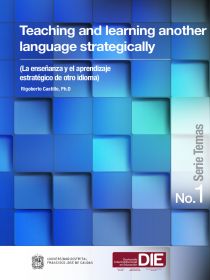

Esta obra está bajo una Licencia Creative Commons Atribución-NoComercial-SinDerivar 4.0 Internacional.
This book emerged from my curiosity to become acquainted with the relation between language acquisition and strategic learning. I want to share with colleagues and with student-teacher-researchers the findings after several years of work with educators. This book attempts to address the question of how to promote experiential learning and problem solving. While in formal education, pupils require to develop the capacity to do something with what is learnt, such knowledge should, among other things, allow people to understand the society in which they live in and to solve real life problems.
| Prólogo: Bitácora de este caleidoscopio para docentes | 7 |
| Acknowledgments | 13 |
| Introduction | 15 |
| Chapter I | |
| Theories that illuminate Strategic Learning | 19 |
| 1. Information Processing Theory | 20 |
| 2. The Dimensions of Literacy | 23 |
| 3. Communicative Competence | 25 |
| 4. Strategic Learning: Background, theory and research | 28 |
| Chapter II | |
| Strategic learning and reading competence | 37 |
| A structure for strategic learning and reading | 40 |
| Types of knowledge reading calls for and their corresponding strategies | 42 |
| 1. Knowledge of the content and experience (images and concepts) call for strategies for generating ideas (identification of macroframe) | 42 |
| 2. Procedural knowledge to organize the content calls for strategies for organizing ideas | 45 |
| 3. Knowledge of written discourse conventions call for editing strategies The control and verification of understanding runs through the revision for coherence | 46 |
| 4. Procedural knowledge required to apply the other types of knowledge in comparing a written discourse call for strategies for recognizing relevance (clarification and simplification) | 48 |
| 5. Procedural knowledge required to evaluate a written discourse calls for strategies for questioning textual information (taking a critical stand) | 49 |
| Discussion | 53 |
| Chapter III | |
| Strategic learning and listening competence | 55 |
| Word-level factors | 58 |
| Sentence-level factors | 58 |
| Discourse-level factors | 59 |
| Task-processing factors | 60 |
| A structure for the development of listening | 63 |
| Discussion | 71 |
| Chapter IV | |
| Strategic learning and speaking competence | 73 |
| A structure for promoting L2 speaking | 74 |
| 1. Knowledge of the content and experience (images and concepts) calls for strategies for recognizing ideas (identification of macroframe) | 74 |
| 2. Procedural knowledge to organize the content calls for strategies for organizing ideas (identification of schema) | 76 |
| 3. Knowledge of conventions of speaking calls for strategies for editing ideas (control and verification) | 78 |
| 4. Procedural knowledge required to apply the other types of knowledge in comparing a spoken discourse calls for strategies for recognizing relevance of ideas and coherence | 79 |
| Chapter V | |
| Strategic learning and writing competence | 81 |
| A theory of writing as a recursive process | 81 |
| A structure for strategic learning and writing | 83 |
| 1. Knowledge of the content | 85 |
| 2. Procedural knowledge to organize the content | 87 |
| 3. Knowledge of conventions of writing | 92 |
| 4. Procedural knowledge required to apply the other types of knowledge in comparing a written product | 93 |
| Discussion | 94 |
| Chapter VI | |
| Implications of strategic learning for language education | 97 |
| References | 101 |
| Further reading | 109 |
| Appendix 1 | 115 |
| Appendix 2 | 117 |

Redes Sociales DIE-UD